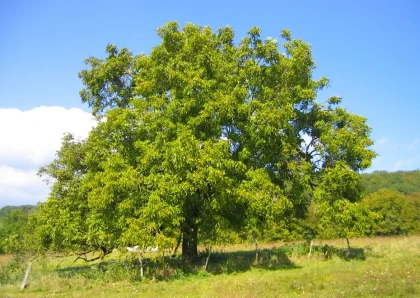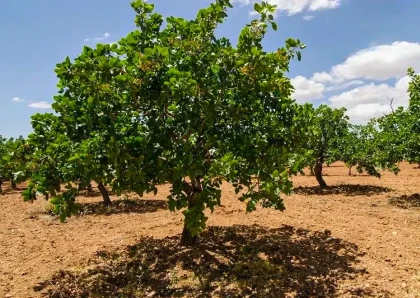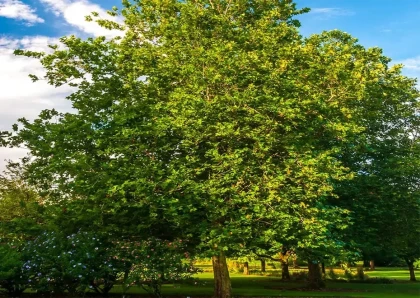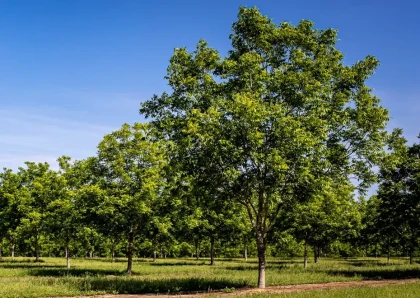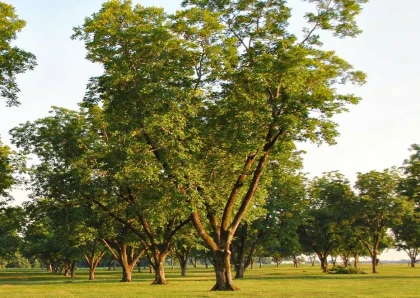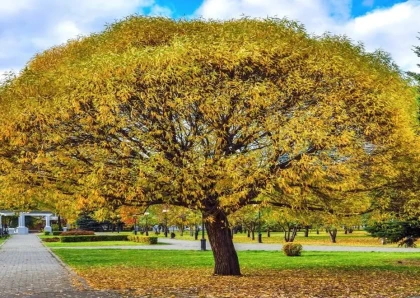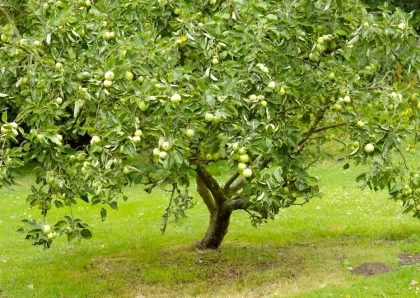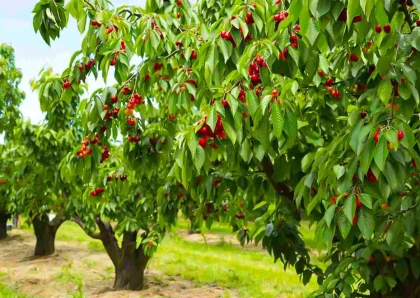
Eastern Redbud
Overview
The American Redbud Tree (Cercis canadensis) is a charming and versatile deciduous tree that is native to eastern North America. It is widely admired for its beautiful display of pink or purple flowers that cover the branches in early spring, creating a stunning visual spectacle. The flowers emerge before the leaves, adding to the tree's unique appeal. As the leaves unfurl, they reveal their distinctive heart shape, further enhancing the tree's aesthetic value.
With its moderate size, the American Redbud Tree typically reaches a height of 20 to 30 feet, although certain varieties may grow taller or remain more compact. Its rounded canopy provides a pleasant shade during the summer months, making it a delightful addition to gardens, parks, and urban landscapes.
The American Redbud Tree offers different cultivars, each with its own unique characteristics and variations in flower color, leaf shape, and overall size. Popular cultivars include 'Forest Pansy,' known for its deep purple foliage, 'Lavender Twist,' a weeping variety with lavender flowers, and 'Hearts of Gold,' featuring golden leaves that turn orange in the fall. These cultivars offer options to suit different preferences and landscape designs.
American Redbud Tree is primarily admired for its aesthetic appeal, the wood of this tree is not commonly used for commercial purposes. Its small size and relatively low availability limit its applications in the timber industry. However, the wood can still be utilized for small woodworking projects, such as crafts, turnings, and decorative items.
What are the different types of American Redbud Tree?
There are several different cultivars of American Redbud Tree, including:
- Forest Pansy: This cultivar has dark red-purple leaves and showy pink or lavender blossoms in spring.
- Oklahoma: This cultivar is known for its large, bright pink flowers.
- Rosebud: This cultivar has deep pink flowers that are slightly darker than those of other cultivars.
Different types of wood products can be made from American Redbud Tree?
- Crafts: The fine-grained and moderately hard wood of the American Redbud Tree is suitable for crafting small wooden items, such as bowls, boxes, and jewelry.
- Turnings: The wood's attractive grain patterns and unique coloration make it ideal for turning projects, including pens, handles, and small decorative objects.
- Decorative Items: American Redbud Tree wood can be used to create intricate carvings, inlays, and scrollwork for furniture, picture frames, and other decorative pieces.
- Musical Instruments: While less common, the wood of the American Redbud Tree can be utilized in the construction of musical instruments, such as guitars, ukuleles, or woodwind instrument components.
- Intarsia and Marquetry: The vibrant color of the American Redbud Tree wood can be incorporated into intarsia and marquetry projects, adding a unique touch to furniture, wall hangings, and artwork.
Benefits of American Redbud Tree:
- Beautiful spring blooms add color and charm to the landscape.
- Attracts pollinators like bees and butterflies.
- Provides shade and shelter for birds and wildlife.
- Tolerates a variety of soil conditions.
- Requires minimal maintenance once established.
Cons of American Redbud Tree:
- Can be susceptible to certain diseases, such as canker and leaf spot.
- May require pruning to maintain shape and remove dead or damaged branches.
- Limited wood product applications due to the small size of the tree.
Tips for planting and maintaining American Redbud Tree:
- Choose a suitable location: Plant the American Redbud Tree in well-drained soil that is rich in organic matter. Select a spot that receives full sun or partial shade for optimal growth and flowering.
- Proper watering: Provide regular watering, especially during the first year after planting, to help establish a strong root system. Water deeply and consistently, ensuring the soil is evenly moist but not waterlogged. During dry spells, increase watering frequency.
- Mulching: Apply a layer of organic mulch around the base of the tree, keeping it a few inches away from the trunk. Mulching helps conserve soil moisture, suppresses weeds, and regulates soil temperature.
- Pruning: Prune selectively in late winter or early spring to remove any dead, damaged, or crossing branches. This will enhance the tree's structure, promote air circulation, and maintain a healthy shape. Avoid heavy pruning, as it can impact flowering.
- Protection from extreme conditions: Young American Redbud Trees may need protection from extreme temperatures and harsh winds. Consider providing temporary shade or windbreaks until the tree becomes more established.
- Regular maintenance: Monitor the tree for pests and diseases, and take appropriate measures if necessary. Keep the area around the tree free from debris and weeds. Fertilize sparingly, following recommended guidelines, to avoid excessive growth and maintain overall health.
Conclusion
The American Redbud Tree is a beautiful and versatile addition to any landscape. With its vibrant spring flowers, heart-shaped leaves, and adaptability, it brings visual interest and attracts wildlife. While it may require some care, the benefits outweigh the potential drawbacks, making it a popular choice among gardeners and nature enthusiasts.
FAQs
- When does the American Redbud Tree bloom?
- How tall does the American Redbud Tree grow?
- Does the American Redbud Tree require full sun?
- Can I grow the American Redbud Tree in a container?
- How often should I water my American Redbud Tree?
The American Redbud Tree typically blooms in early spring, before the leaves emerge.
The American Redbud Tree can reach a height of 20 to 30 feet, depending on the variety and growing conditions.
While the American Redbud Tree prefers full sun, it can also tolerate partial shade.
While it is possible to grow the American Redbud Tree in a container, it is best suited for planting directly in the ground for optimal growth and development.
Water your American Redbud Tree regularly, especially during dry periods. Aim for deep, thorough watering rather than frequent shallow watering.
No listings available
Related Products
Early Elberta Peach
Early Elberta Peach is a highly sought-after peach tree variety that stands out for its remarkable taste and ability to yield fruit earlier than...
Kwik-Krop Walnut Tree
History of the Tree The Kwik-Krop Walnut Tree has a rich history that dates back many decades. Developed by renowned horticulturist Dr. John A....
Famosa Pistachio Tree
History of the Tree The Famosa Pistachio Tree, scientifically known as Pistacia vera 'Famosa,' is a revered variety of pistachio tree with a fascinating...
Columbia Sycamore Tree
Certainly! The Columbia Sycamore Tree (Platanus x acerifolia 'Columbia') is a majestic and highly sought-after deciduous tree. It is a hybrid of the American...
Hardy Giant Pecan Tree
History of the Tree The Hardy Giant Pecan Tree, scientifically known as Carya illinoinensis 'Hardy Giant,' is a remarkable pecan tree variety with a...
Barcelona Filbert Hazelnut Tree
History of the Tree The Barcelona Filbert Hazelnut Tree, also known as Corylus avellana 'Barcelona,' is a popular cultivar of the European hazelnut tree....
Pawnee Pecan Tree
History of the Tree The Pawnee Pecan is a notable pecan tree variety that was developed by researchers at the USDA Agricultural Research Service....
Globe Navajo Willow Tree
The Globe Navajo Willow Tree, scientifically known as Salix matsudana 'Navajo,' is a popular deciduous tree known for its unique and appealing characteristics. This...
Granny Smith Apple Tree
History of the Tree The Granny Smith Apple Tree is a renowned apple variety that originated in Australia in the 1860s. It was discovered...
Benton Sweet Cherry Tree
History of the Tree The Benton Sweet Cherry Tree is a modern cherry variety developed through extensive breeding and selection. It was introduced by...
Questions & Answers
What do you want to know about this product?
Reviews (5)
GardenWhisperer55
Enchanting Marvel of the Spring
The Floral Enchanter captivates with its magical display of vibrant blooms. A bewitching addition to any landscape!
FloraFanatic123
Graceful Elegance and Natural Beauty
The Blossom Ballerina pirouettes into my garden, delighting with its dainty flowers and graceful form. A true horticultural treasure!
TreeArtist77
Nature's Artistry on Display
The Petal Painter adds a splash of color to my garden canvas, transforming it into a masterpiece. A botanical marvel!
Blossom Whisperer98
A Blooming Delight for the Senses
The Rosy Rhapsody is like a springtime symphony, its pink blooms enchanting all who behold. A true arboreal masterpiece!
TreeTuner
Floral Symphony in my Backyard
The Bloom Maestro turns my backyard into a symphony of color and fragrance.







